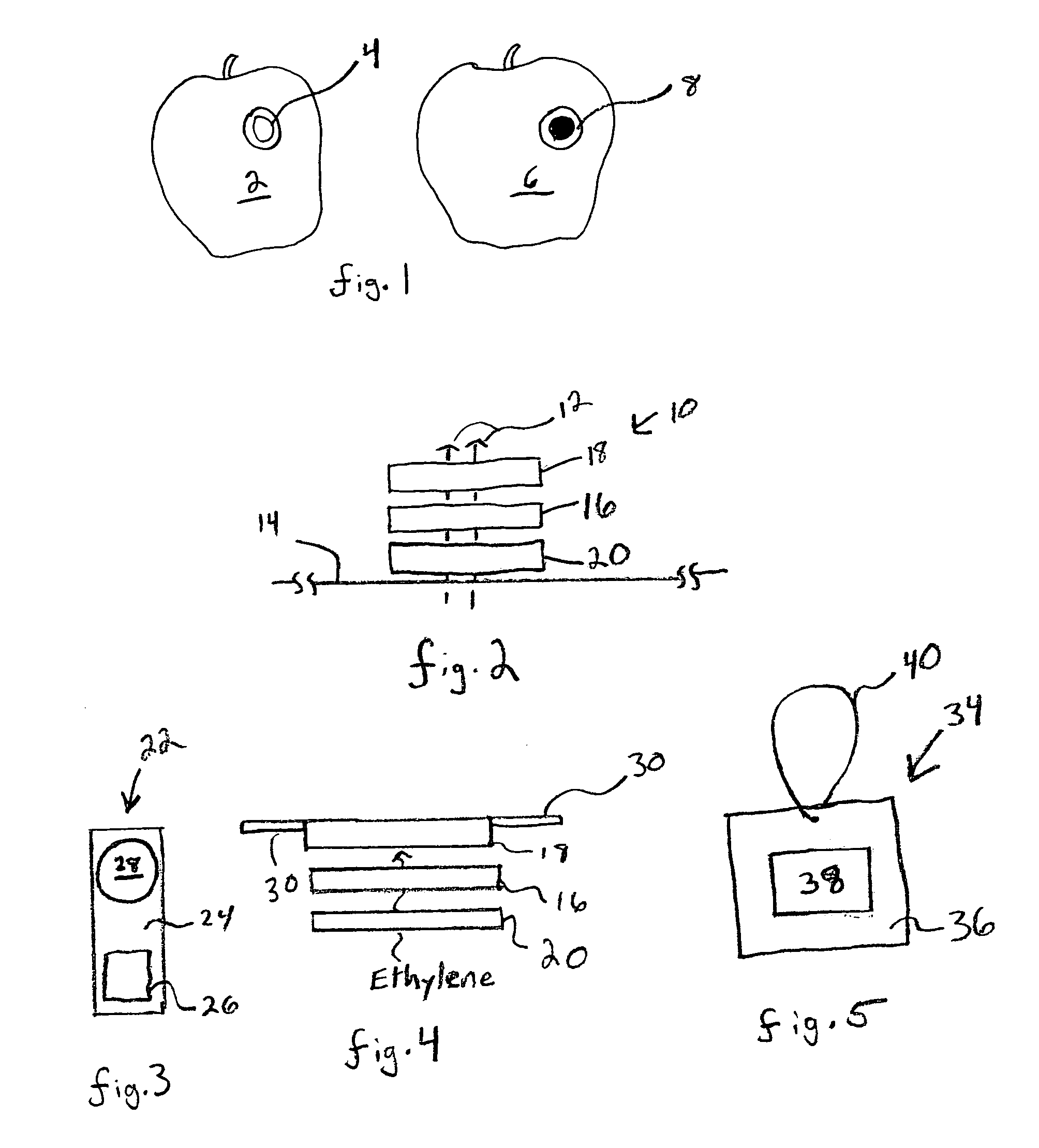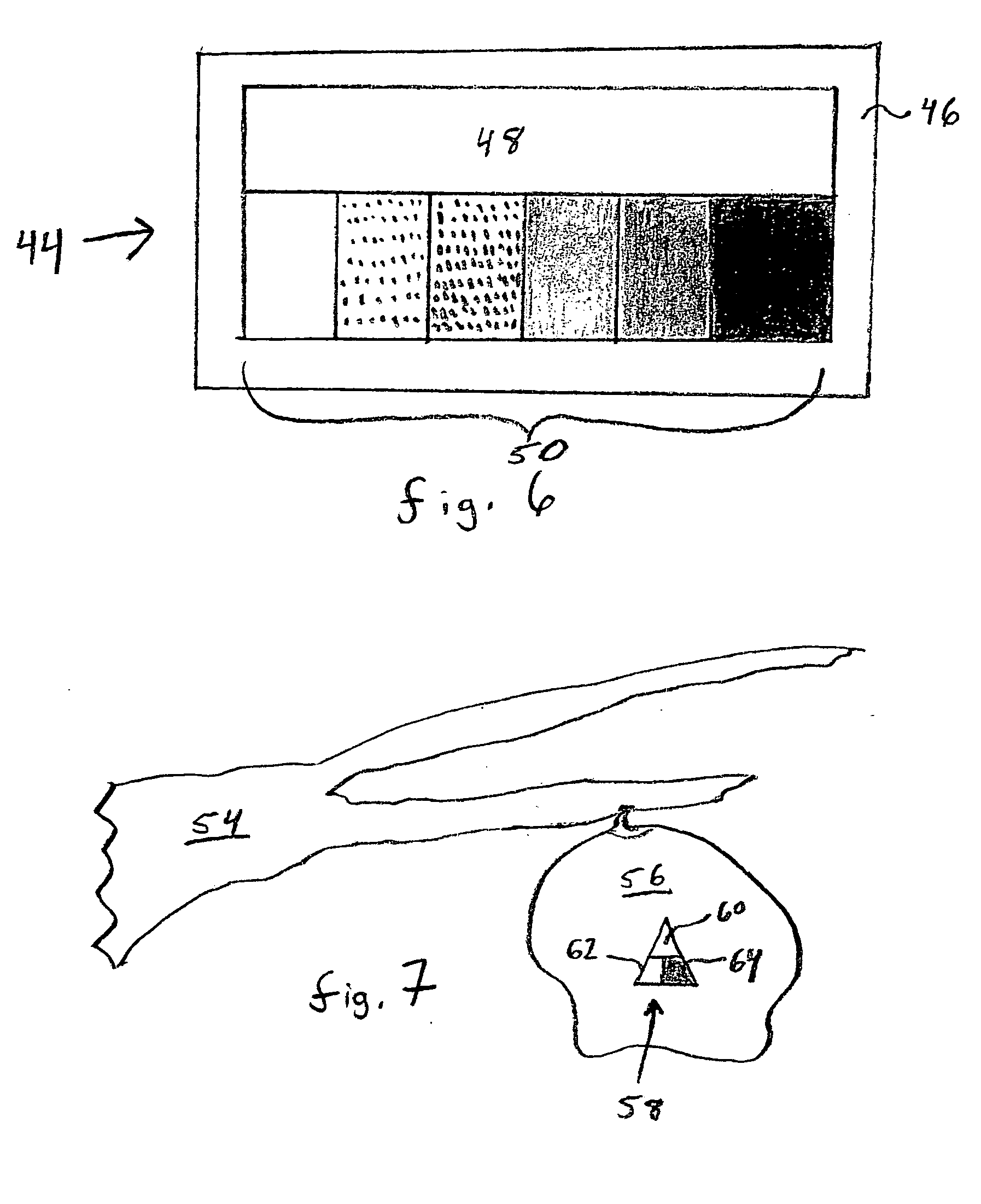Non-invasive colorimetric ripeness indicator
a colorimetric and indicator technology, applied in the field of ripeness indicators, can solve the problems of inability to reliably determine the most favorable harvest, the time of harvest and post-harvest shipping, and the subjective judgment of growers about which blocks of ripening apples are ready for harvest or post-harvest shipping, etc., and achieve the effect of reliable measurement of fruit ripeness, quick and inexpensiv
- Summary
- Abstract
- Description
- Claims
- Application Information
AI Technical Summary
Benefits of technology
Problems solved by technology
Method used
Image
Examples
example 1
[0104] All of the colorimetric reagents described above were tested by placing a small volume (5-15 uL) on several substrates, including filter paper, porous membranes, paper, coated paper, Durapore,™ and nitrocellulose. This substrate was exposed to ethylene (from a gas cylinder and from ripening fruits, including apples, peaches, oranges, pears, and others). The color of the reagent exposed to ethylene was then compared to that of unexposed control indicators. Color evolution began seconds after placement of the substrate and continued for minutes to days, depending on reagents applied and on the concentration of ethylene.
[0105] As seen in FIG. 8, substrates containing the KMnO4 reagents were placed on an apple and evaluated immediately after placement, after 6 hours, and after 24 hours. Note the strong change in color over time from purple to brown, indicating substantial ethylene release.
[0106] The sensors of the invention respond to as little as 0.1 ppm of ethylene, although ...
example 2
[0108] Two different types of reagents, based on color changes of KMnO4 and Molybdenum blue, are tested. These are implemented in two configurations: membranes or precipitated on activated silica (labeled (1) and (2) below).
[0109] (1) Ethylene is readily oxidized by potassium permanganate (KMnO4) to form manganese oxide and ethylene glycol. During the oxidation of ethylene, the purple permanganate solution changes to a brown suspension of MnO2, this reaction, also known as the Baeyer Test, is used to detect unsaturated hydrocarbons (FIG. 13).
[0110] (2) In the presence of a reducing agent such as ethylene, the color of a molybdenum reagent catalyzed by palladium sulfate changes from pale yellow to blue (approximate composition Mo3O8). This approach is similar to the commercial ethylene Kitagawa detection tube's reaction. We have evaluated various formulations of palladium-catalyzed molybdate oxides, based on reviews of the literature and the reaction of the commercial ethylene dete...
example 3
[0113] We have developed a color scale by using the color of membranes exposed to various concentrations of ethylene (FIG. 14). This color scale serves as a guide for correlation of color change with ethylene concentration for a specific produce item, apples.
PUM
 Login to View More
Login to View More Abstract
Description
Claims
Application Information
 Login to View More
Login to View More - R&D
- Intellectual Property
- Life Sciences
- Materials
- Tech Scout
- Unparalleled Data Quality
- Higher Quality Content
- 60% Fewer Hallucinations
Browse by: Latest US Patents, China's latest patents, Technical Efficacy Thesaurus, Application Domain, Technology Topic, Popular Technical Reports.
© 2025 PatSnap. All rights reserved.Legal|Privacy policy|Modern Slavery Act Transparency Statement|Sitemap|About US| Contact US: help@patsnap.com



